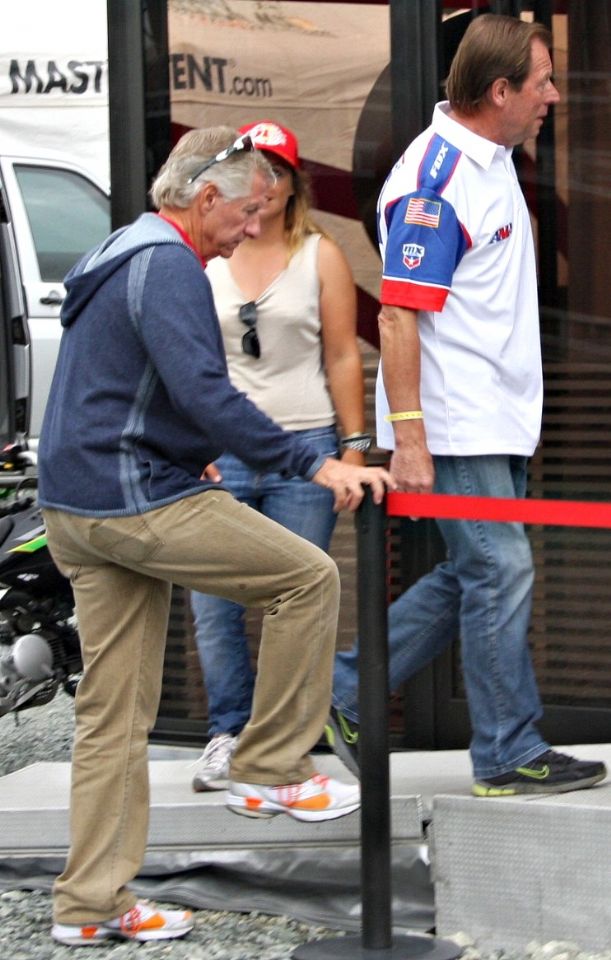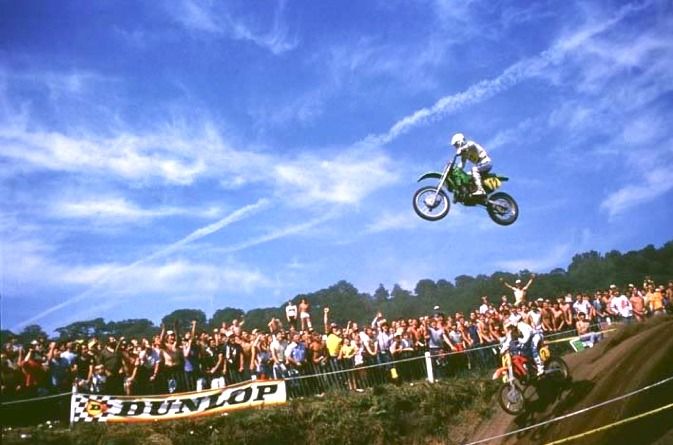
![]()
Famous Faces - Part 2 Everyone knows the guy in front, Roger De Coster, but I had no idea who the man behind him was. They were going into the Alpinestar's dining room for lunch. Everyone knows the guy in front, Roger De Coster, but I had no idea who the man behind him was. They were going into the Alpinestar's dining room for lunch. When Tony Cooksley saw the photo he said straight away; "That's Georges Jobé." Jobé is former five-time FIM Motocross World Champion from Belgium. He also won several Belgian National MX Championships in a career that spanned from 1979 to 1992. Jobé was crowned FIM World 250cc Motocross Champion in 1980 and 1983, and later went on to be crowned FIM World 500cc Motocross Champion in 1987, 1991 and 1992. Jobé's 1987 500cc championship was notable as he won riding a ‘privateer’ Honda CR500. Most of his rivals were on the official factory teams of Honda, Kawasaki or KTM. In 2007 Jobé was paralysed
whilst training young riders in Dubai. After four years of intense
rehabilitation, he has recovered only to be recently diagnosed with leukemia and is now
currently facing the challenge to regain his health.
Tony Cooksley told the story about when, at a Hawkestone Park GP there was a famous photo of Jobé jumping the 'Bombhole' over the top of, the then 1st placed, Andre Malherbe.  Here is that photo courtesy of Nick Haskell. Retired British rider Rob Andrews takes up the story: "This Nick Haskell photo of
Georges Jobé jumping over the head of Andre Malherbe is arguably one of the
greatest GP photographs of all time. It was taken at the British 500 Grand Prix
in 1984, Jobe’s amazing pass in front of electrified crowds immortalised the
Belgian, and equally secured a place in history for the obstacle itself.
The Hawkstone double jump was never conceived as such. Riders used to race down from the famous bombhole and head full bore for the finish, with only a flat out ski jump, known for many years as the ‘Girling Leap’, to interrupt their progress. As suspension improved and speeds rose, the Salop Club needed to slow the riders down and so built two huge mounds, with a deep chasm in between. I think the jump had been in existence for a while before anybody really considered having a go at the two. As a potential double it was way bigger than anything seen before on the GP circuit, and was a difficult obstacle to judge. The approach was blind, with no view of the second jump and no indication therefore of how fast and how far you needed to jump. The straight before was rough and rutted, as was all of Hawkstone, and the back side to the jump was steep and a tiny target. Overjumping wasn’t really a good idea either as it would mean flat landing from a huge height. All in all a nasty, scary obstacle. At the 1984 British GP a team of three American riders came over, sponsored by French clothing and accessory firm Motocross Marketing. Eric McKenna, Eric Eaton and Phil Larson were all riding Honda’s I believe. The exact details seem to have been lost in the cloudiness of time, but one of these guys was the first to attempt and clear the jump, and Phil Larson executed the deed comfortably. Georges Jobé was soon to
follow, and subsequently several other riders had a crack, with differering
levels of success. Eric Geboers was the most noticeable casualty, when he
over-jumped, flat landed it and broke his tibia and fibia in the resulting impact! David Thorpe attempted it
too, casing it hard. He chose to not jump it again, but still went on to win
both motos!
Jobé meanwhile, jumped confidently and consistently and used the jump on and off throughout the races, passing Belgian championship rival Malherbe in Moto 2. In the twelve months or so following the GP a few other domestic riders successfully cleared the Hawkstone double. Scotsman Paul Chiappa was the first Brit I believe, as well as Scott Gardner. However, following pressure from the ACU and FIM, who had implemented a blanket ban on double jumps on safety grounds, Hawkstone’s most famous obstacle was converted into a tabletop soon after." |





